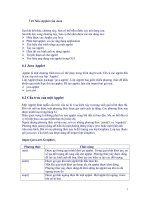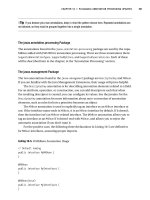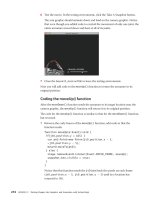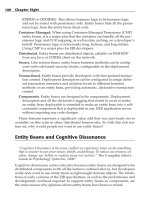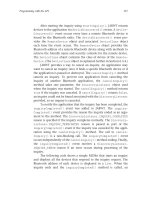Patterns in JavaTM, Volume 3 Java Enterprise Java Enterprise Design Patterns phần 8 doc
Bạn đang xem bản rút gọn của tài liệu. Xem và tải ngay bản đầy đủ của tài liệu tại đây (363.11 KB, 50 trang )
listing of the TransactionParticipantIF interface. All objects that par-
ticipate in a transaction must either directly implement the Transaction-
ParticipantIF
interface or be wrapped by an adapter object that
implements the TransactionParticipantIF interface.
public interface TransactionParticipantIF {
/**
* This method does not return until it can associate a
* lock on the participating object with the current
* thread.
*/
public void lock() ;
/**
* Return an object that encapsulates the state of the
* participating object.
*/
public SnapshotIF captureState() ;
/**
* Restore the state of the participating object from the
* information encapsulated in the given object. The given
* object must have previously been returned by this
* object’s captureState method.
*/
public void restoreState(SnapshotIF state) ;
/**
* Release a previously obtained lock.
*/
public void unlock() ;
} // interface TransactionParticipantIF
Here is a listing of the TransactionManager class. An interesting
thing about the TransactionManager class is that it delegates most of its
work to a private inner class called Transaction. When a transaction is
started, a TransactionManager object creates and associates a
Transaction object with the current thread. This organization is based on
the assumption that transactions are single-threaded. Every time a
TransactionManager object is asked to do something, it uses the
Transaction object that it previously created for the current thread.
public class TransactionManager {
private ThreadLocal myStack;
private ThreadLocal currentTransaction;
The myStack instance variable associates a Stack object with the cur-
rent thread. The stack is used to save the values of objects when they are
locked.
The
currentTransaction instance variable associates the current
transaction a thread is working on with that thread. If the transaction is
342
■
CHAPTER SEVEN
nested in another transaction, its enclosing transaction is saved on the stack.
The TransactionManager class’s constructor initializes these variables.
public TransactionManager() {
myStack = new ThreadLocal();
myStack.set(new Stack());
currentTransaction = new ThreadLocal();
} // TransactionManager()
/**
* Start a new transaction. If there is a transaction in
* progress, the transactions nest.
*/
public void startTransaction() {
getStack().push(getCurrentTransaction());
setCurrentTransaction(new Transaction());
} // startTransaction()
A TransactionManager object delegates most of the work of its other
operations to the current thread’s current Transaction object.
/**
* Add an object to the current transaction.
*/
public void enroll(TransactionParticipantIF obj) {
checkCurrentTransaction();
getCurrentTransaction().enroll(obj);
} // enroll(TransactionParticipantIF)
/**
* Commit the current transaction.
*/
public void commit() {
checkCurrentTransaction();
getCurrentTransaction().commit();
} // commit()
/**
* Abort the current transaction.
*/
public void abort() {
checkCurrentTransaction();
getCurrentTransaction().abort();
} // abort()
Here are helper methods that are used by the preceding public methods.
/**
* Throw an <code>IllegalStateException</code> if there is
* no current transaction.
*/
private void checkCurrentTransaction() {
if (getCurrentTransaction()==null) {
throw new IllegalStateException("No transaction");
Concurrency Patterns
■
343
} //if
} // checkCurrentTransaction()
/**
* Return the transaction manager stack associated with the
* current thread.
*/
private Stack getStack() {
return (Stack)myStack.get();
} // getStack()
/**
* Return the current Transaction object.
*/
private Transaction getCurrentTransaction() {
return (Transaction)currentTransaction.get();
} // getCurrentTransaction()
/**
* Set the current Transaction object.
*/
private void setCurrentTransaction(Transaction t) {
currentTransaction.set(t);
} //setCurrentTransaction(Transaction)
Transactions are represented as instances of this private class:
private class Transaction {
// Collection of TransactionParticipantIF objects.
private ArrayList participants = new ArrayList();
/**
* Add the given object to this transaction to be
* modified.
*/
void enroll(TransactionParticipantIF obj) {
obj.lock();
getStack().push(obj.captureState());
participants.add(obj);
} // enroll(TransactionParticipantIF)
/**
* commit this transaction.
*/
void commit() {
int count;
count = participants.size();
for (int i=count-1; i>=0; i ) {
TransactionParticipantIF p;
p = (TransactionParticipantIF)
participants.get(i);
p.unlock();
getStack().pop();
344
■
CHAPTER SEVEN
} // for
Transaction prevTransaction;
prevTransaction = (Transaction)getStack().pop();
setCurrentTransaction(prevTransaction);
} // commit()
/**
* Abort this transaction.
*/
void abort() {
int count;
count = participants.size();
for (int i=count-1; i>=0; i ) {
SnapshotIF state;
state = (SnapshotIF)getStack().pop();
TransactionParticipantIF participant
=(TransactionParticipantIF)participants.get(i);
participant.restoreState(state);
participant.unlock();
} // for
setCurrentTransaction((Transaction)getStack().pop());
} // abort()
} // class Transaction
} // class TransactionManager
RELATED PATTERNS
ACID Transaction. The ACID Transaction pattern contains more
information about the atomic and isolated properties of trans-
actions.
Decorator. The logic for a TransactionParticipantIF interface
for a class that participates in a transaction is often imple-
mented using the Decorator pattern (described in Volume 1).
Snapshot. The Transaction State Stack pattern uses the Snapshot
pattern (described in Volume 1) to encapsulate the current state
of an object in a way suitable for being put on a stack and possi-
bly being restored later.
Concurrency Patterns
■
345
CHAPTER
Temporal Patterns
347
Time Server (349)
Versioned Object (355)
Temporal Property (373)
The patterns in this chapter describe ways that applications manage
time-related data. There are only a few patterns in this chapter. That
should not be taken to mean that handling time is a simple matter. Issues
related to handling and modeling time can be very complex. The small
number of patterns is a symptom that the state of the art related to time is
less well developed than other areas.
8
This pattern was previously described in [Lange98].
SYNOPSIS
In order for some distributed applications to function correctly, the clocks
on the computers they run on must be synchronized. Ensure that clocks
on multiple computers are synchronized by synchronizing them with a
common clock.
CONTEXT
You are designing an employee timekeeping system. The system
architecture will include multiple timekeeping terminals. Employees
will use the timekeeping terminals to indicate when they begin working
a shift, are done working, and other timekeeping events. The terminals
report timekeeping events to a server that collects the events in a
database.
Employees may use different timekeeping terminals to indicate the
beginning of a shift and the end of a shift. When a timekeeping terminal
reports a timekeeping event, the time of the event is determined by the
timekeeping terminal’s own clock. If the clocks on the different terminals
are not synchronized, the duration of the employee’s shift will appear to be
longer or shorter than it actually was.
FORCES
⁄
An application is distributed over multiple computers.
⁄
A distributed application is required to do things at predetermined
times, to ensure the relative order of its actions. If the clocks on the
computers an application is running on are not synchronized, their
differences can cause the application to perform its actions in the
wrong relative order.
⁄
A distributed application records events it receives on different
computers. It is important to accurately determine the elapsed time
Temporal Patterns
■
349
Time Server
between events, even if the events are received on different
computers.
⁄
Relying on the continuous availability of a single central clock to
determine the time that an event occurs can reduce the availability of
an application, since the application will be unable to function if the
clock becomes unavailable. Relying on a single central clock can also
limit the performance of a distributed application, since relying on a
central clock or any other central resource can result in that
resource’s becoming a bottleneck.
Ÿ
Relying on a remote clock can introduce inaccuracies into the deter-
mination of the time if the network delays encountered in communi-
cating with the clock vary in an unpredictable way.
SOLUTION
Have each computer that hosts part of a distributed application periodi-
cally set its own clock from the clock of a remote computer that functions
as a time server.
The frequency with which a host synchronizes its clock with the time
server should be often enough that the clocks do not noticeably diverge.
Typically, this is once every hour or two. Though this is more frequent than
may be required to keep clocks synchronized, it serves to minimize the
consequences of the time server’s being unavailable when another com-
puter wants to synchronize its clock with the time server’s.
Communication between a computer requesting the current time
and a time server takes some amount of time. There is no way to know in
advance exactly how long it will take. After a computer has requested the
current time from a time server and it has received the time, it knows the
total elapsed time that the request took. It does not know how long the
request took to reach the time server and it does not know how long the
response took to get from the server to the requesting computer. The
elapsed time between when a request reaches a server and when the
response leaves the server is usually very small. For practical purposes,
the time that it takes for the response to travel from the server to the
requesting computer is the inaccuracy of the response when it reaches the
requesting computer. A reasonable way to estimate this time is to assume
that the time it takes the request to travel from the requesting computer
to the server is equal to the time it takes the response to travel from the
server to the requesting computer. This makes our estimate of the time it
takes for the response to get to the requesting computer one half of the
elapsed time between when the request was issued and the response was
received.
350
■
CHAPTER EIGHT
TEAMFLY
Team-Fly
®
When the requesting computer receives the current time from a time
server, it adds one half of the elapsed time to the time it receives and uses
that as the actual current time.
CONSEQUENCES
⁄
Given events recorded by different computers, the Time Server pat-
tern allows the times at which those events occurred to be accurately
compared.
Ÿ
If the time server becomes unavailable for a long period of time, a
distributed application that relies on the clocks of multiple comput-
ers being synchronized may fail. This situation can generally be
avoided by using multiple time servers, as is discussed under the fol-
lowing “Implementation” heading.
IMPLEMENTATION
The Time Server pattern is most often implemented at the system level
rather than at the application level. If the computers in question are general-
purpose computers that run multiple applications, then implementing the
Time Server pattern at the system level allows all applications that run on
the computer to share the benefits of a single implementation of the Time
Server pattern.
In some cases, it is not possible for a distributed application to
assume that the time clocks of the computers it runs on are synchronized.
In that case, the application must have an application-level implementa-
tion of the Time Server pattern.
By using multiple time servers, you can minimize the effects of
erratic network speeds and greatly increase the availability of the current
time service. Computing the current time by averaging the adjusted results
from multiple time servers minimizes the effects of erratic network speeds.
Using multiple time servers ensures that the failure of a single time server
does not make the current time unavailable.
If the Time Server pattern is implemented at the application level, it
will generally not be possible for the class that implements the pattern to
set the system clock. Instead, the class can keep track of the difference
between the local system time and the time server’s time. By making the
time client class the source of the current time for the rest of the applica-
tion, the time client class can achieve the same effect by applying the dif-
ference between the local and server time to the system time before
returning it. The shortcoming to this approach is that if the local clock is
Temporal Patterns
■
351
set to another time, the time client class will be applying the wrong differ-
ence to the time until it next consults the server.
KNOWN USES
The author is aware of a proprietary employee timekeeping application
that uses the Time Server pattern to synchronize the time on multiple
timekeeping terminals.
The Time Server pattern is used in some point-of-sale systems to syn-
chronize the time in cash registers.
The Time Server pattern is also used in the HP TraceVue Series 50
product. This is used during the birth of a child to track its vital signs.
CODE EXAMPLE
This code example consists of just a simple time server and time client
class. The server implements this interface:
public interface TimeServerIF extends Remote {
// The name of all time servers
public static final String TIME_SERVER_NAME = "time";
/**
* Return the current time
*/
public Calendar currentTime() throws RemoteException;
} // interface TimeServerIF
Here is the time server class that implements the interface:
public class TimeServer implements TimeServerIF {
/**
* Constructor
*/
public TimeServer() throws RemoteException,
MalformedURLException,
UnknownHostException {
// Note that the name TIME_SERVER_NAME is hard-coded,
// which means that only one TimeServer object can
// exist on each host machine.
Naming.rebind(TIME_SERVER_NAME, this);
} // constructor()
/**
* Return the current time
*/
public Calendar currentTime() {
return Calendar.getInstance();
352
■
CHAPTER EIGHT
} // currentTime()
} // class TimeServer
Finally, here is the class that is the server’s client:
public class TimeClient {
private static final long UPDATE_PERIOD
= 1000*60*60; // 1 hour
// difference between the local and server time
private int timeDifference;
private TimeServerIF theTimeServer;
/**
* constructor
*/
public TimeClient(String timeHost)
throws RemoteException,
UnknownHostException,
NotBoundException,
MalformedURLException {
String urlName = "//" + timeHost
+ "/" + TimeServerIF.TIME_SERVER_NAME;
theTimeServer = (TimeServerIF)Naming.lookup(urlName);
new DifferenceUpdater();
} // constructor()
public Calendar currentTime() {
Calendar now = Calendar.getInstance();
now.add(Calendar.MILLISECOND, -timeDifference);
return now;
} // currentTimeMillis()
private class DifferenceUpdater extends Thread {
public void run() {
try {
while (!isInterrupted()) {
try {
long startTime =
System.currentTimeMillis();
Calendar serverTime =
theTimeServer.currentTime();
long endTime =
System.currentTimeMillis();
long latency = (endTime-startTime)/2;
long adjustedTime
= serverTime.getTime().getTime()+latency;
timeDifference = (int)(endTime-adjustedTime);
} catch (RemoteException e) {
// Nothing to do but keep trying.
} // try
sleep(UPDATE_PERIOD);
Temporal Patterns
■
353
} // while
} catch (InterruptedException e) {
// It’s all over
} // try
} // run()
} // class DifferenceUpdater
} // class TimeClient
RELATED PATTERNS
Versioned Object. Distributed applications that use the Versioned
Object pattern are likely to also use the Time Server pattern.
Temporal Property. Distributed applications that use the Temporal
Property pattern are likely to also use the Time Server pattern.
354
■
CHAPTER EIGHT
This pattern was previously described in [Lange98].
SYNOPSIS
You may need to access previous or future states of an object. When an
object gets a new state, keep both its new and its previous states. Identify
the states by a timestamp or a version number. Allow access to a specific
state of an object by identifying its timestamp or version number.
CONTEXT
You are designing an inventory management system. The purpose of this
system is to manage information about items that a business uses and
sells. Over time, the information for a given item may change. For exam-
ple, a business may get an item from a different vendor. When that hap-
pens, some of the item’s attributes may be different. In addition to the
vendor, the dimensions, the exact description, and perhaps the weight of
the item also change
The system you design must be able to use an item’s new and old
information at the same time. It must be able to simultaneously describe
the attributes of an item that a business used last week, a newer version of
the item that is sitting on the warehouse shelves now, and the newest ver-
sion of the item that is on order.
As you design the classes for the inventory management system, you
include an ItemDescription class in the design. The nature of the system
requires that when an Item object’s description or state changes, both the
new and old states are kept. The different states of an Item object are dis-
tinguished by the time interval for which the state is valid. When getting
an item’s weight, textual description, or other information from an Item
object, it is necessary to specify a point in time so that the object can know
which of its states to consult. Figure 8.1 is a class diagram that shows a
design that supports this.
In this design, ItemDescription objects do not contain their own state.
Instead, they keep their states in a collection of ItemDescriptionVersion
objects that is keyed to the time interval for which each state is valid.
Temporal Patterns
■
355
Versioned Object
FORCES
⁄
The state of an object may change.
⁄
When the state of an object changes, the change usually involves
more than one of the object’s attributes.
⁄
In addition to accessing the current state of an object, you need to
access other states that it had or will have at given points in time.
⁄
Objects are stored in a database that does not incorporate the con-
cept of time-based versioning in its data model.
Ÿ
If an existing application was designed to only keep the current state
of an object, retrofitting it to keep the object’s different states over
time may involve a very large effort.
SOLUTION
When the state of a business object changes, do not discard the previous
state. Instead, keep the new state and the previous state, distinguishing
between them by the time intervals when each state is valid. Every time
the state of a business object is fetched, it must happen in the context of a
point in time. Figure 8.2 shows this design.
In this design, the state of a BusinessObject is extrinsic. Its state does
not reside in the BusinessObject instance itself, but in associated instances
of BusinessObjectState. The only attributes of BusinessObject that are
intrinsic (reside within instances of the class) are those that are immutable.
If the value of an attribute of a BusinessObject instance can change, then it
is part of its state and must be kept in a BusinessObjectState instance.
Instances of BusinessObjectState are associated with instances of
BusinessObject through disjoint time intervals. When the get method
for a
BusinessObject attribute is passed a point in time, that point in
356
■
CHAPTER EIGHT
ItemDescriptionVersion
description:String
name:String
Contains-state
TimeInterval
1
*
1
ItemDescription
ItemId
getItemId( ):long
getDescription(when:Calendar):String
setDescription(when:Calendar, :String)
getName(when:Calendar) : String
setName(when:Calendar, name:String)
▲
FIGURE 8.1 Item class design.
time is contained by either zero or one of the time intervals. If it is con-
tained by one of the time intervals, then the get method returns the value
that corresponds to the time interval.
When an instance of BusinessObject is first created, an instance of
BusinessObjectState is also created. This instance of BusinessObject-
State
contains the initial state of the BusinessObject instance. The time
interval for which the state in this BusinessObjectState applies to the
BusinessObject instance is the entire time it correctly describes the real-
world entity that the BusinessObject represents. In practice, this is often
not known. In absence of this information, an interval stretching from the
beginning to the end of time is usually a good enough approximation.
When something changes about the real-world entity a Business-
Object
represents, the usual consequence is that the BusinessObject needs
to be given a new state. This is a two-part process. First the BusinessObject
instance’s newVersion method is called to indicate that a new state is being
created. The newVersion method is passed the effective time of the change.
Initially the new state is a copy of the state that preceded it. Then the appro-
priate set methods of the BusinessObjectState instance are called to
change the information in the new state to match the real world.
The time interval for the new state is from the effective time to the
end of the interval of the previously latest state. When a new state is cre-
ated, the end time of the interval associated with the previously latest state
changes. The end of the interval becomes the moment in time just before
the effective time of the new state.
Implementations of the Versioned Object pattern involve another
class that has not been discussed yet. This class implements the data struc-
ture responsible for associating BusinessObjectState instances with an
interval of time and finding the appropriate BusinessObjectState
instance for a given point in time. The details of this class are discussed
under the following “Implementation” heading.
Temporal Patterns
■
357
BusinessObjectState
attribute1
attribute2
Contains-state
TimeInterval
1
*
1
BusinessObject
objectId
newVersion(asOf:Calendar)
getObjectId
getAttribute1(when:Calendar)
setAttribute1(newValue, when:Calendar)
getAttribute2(when:Calendar)
setAttribute2(newValue, when:Calendar)
▲
FIGURE 8.2 Versioned Object pattern.
CONSEQUENCES
⁄
The Versioned Object pattern allows an application to recognize that
real-world entities change over time.
Ÿ
The Versioned Object pattern requires that all access to an object’s
state be in the context of a point in time. It generally becomes the
responsibility of clients of a versioned object to provide the context.
Some designs avoid burdening client objects in that way by offering
calls that assume either the last context or the context corresponding
to the current time. These assumptions can sometimes be a source of
bugs or confusion.
Ÿ
The Versioned Object pattern increases the amount of memory needed
to store objects. In particular, even if only one attribute changes, all
of the object’s attributes that are stored in a
BusinessObjectState
instance must be copied. It also makes the details of persisting an
object more complicated.
IMPLEMENTATION
Data Structure
To implement the Versioned Object pattern, you must include a data struc-
ture in your design that associates an interval of time with each
BusinessObjectState instance. It must also be able to find and fetch the
BusinessObjectState instance associated with an interval that includes a
given point in time.
A class that implements this data structure must ensure it does not
contain any intervals that overlap. If it is presented with an interval that
overlaps any intervals already in the data structure, the conflict should be
resolved in favor of the new interval.
The choice of data structure should be based on the number of states
that the average object is expected to have. If it is just a few, then a simple
data structure based on an array or linked list is generally best. If the num-
ber of versions is expected to be large, some sort of tree-based structure
may be best. The IntervalMap class shown under the “Code Example”
heading is an example of this sort of data structure. It is based on an array.
Loading from Persistent Storage
Another implementation issue comes up when versioned objects are
fetched from a persistent store. This issue is based on the observation
that usually only one or sometimes two states of a versioned object are
358
■
CHAPTER EIGHT
of interest in one session. Because of this, loading all the states of a
BusinessObject instance is something that you will usually want to
avoid. It wastes the time that it takes to load states that will never be
used. It is also wastes memory.
A way to avoid loading states is to create a virtual proxy for each state
that is not loaded.* When the content of a state is actually needed, the
proxy for a state causes the state to be loaded. If you expect that at least
one state will be used and there is a good and simple heuristic for guessing
which state will be used, then it may be a more efficient use of time to load
that one state along with the BusinessObject instance. Most often, that
heuristic will be to load the current state of the
BusinessObjectState
instance or its last state.
Saving to Persistent Storage
A different implementation issue comes up when storing an item to persistent
storage. It is unusual for more than one or two states of a BusinessObject
instance to be new or modified since the BusinessObject instance was
loaded from persistent storage. To avoid the overhead of saving states that do
not need to be saved, it is common for BusinessObjectState classes to have
a method that returns true for a BusinessObject instance that needs to be
saved to persistent storage. This method is often called isDirty.
KNOWN USES
The Versioned Object pattern is used in many applications that have to
model real-world entities.
•
It is used in manufacturing software.
•
It is used in application frameworks.
•
It is used in some database engines.
CODE EXAMPLE
The code example for Versioned Object is a class that describes an item
used by a business. Before we look at that class, we will begin by looking at
some support classes. The first class is a class to represent a time interval.
Temporal Patterns
■
359
* The Virtual Proxy pattern is described in Volume 1.
public class Interval {
// The number of milliseconds difference between daylight
// savings and standard time.
private static final long DAYLIGHT_SAVINGS_OFFSET
= 60*60*1000;
/**
* An interval that spans all of time.
*/
public static Interval ETERNITY
= new Interval(Long.MIN_VALUE, Long.MAX_VALUE);
// The start time of this interval, expressed as the number
// of seconds since midnight, January 1, 1970, UTC
private long start;
// The end time of this interval, expressed as the number
// of seconds since midnight, January 1, 1970, UTC
private long end;
/**
* Construct an interval with the given start and end time.
* @param start The start of the interval or null if the
* interval starts at the beginning of time.
* @param end The end of the interval or null if the
* interval ends at the end of time.
*/
public Interval(Calendar start, Calendar end) {
long myStart;
if (start==null) {
myStart = Long.MIN_VALUE;
} else {
myStart = start.getTime().getTime();
} // if
long myEnd;
if (end==null) {
myEnd = Long.MAX_VALUE;
} else {
myEnd = end.getTime().getTime();
} // if
init(myStart, myEnd);
} // constructor(Calendar, Calendar)
/**
* constructor
* @param start
* The start time of this interval, expressed as the
* number of seconds since midnight,
* January 1, 1970, UTC.
* @param end
* The end time of this interval, expressed as the
* number of seconds since midnight,
* January 1, 1970, UTC.
*/
360
■
CHAPTER EIGHT
TEAMFLY
Team-Fly
®
Interval(long start, long end) {
init(start, end);
} // constructor(long, long)
/**
* Common initialization logic
*/
private void init(long start, long end) {
if (end<start) {
String msg = "Ends before it starts";
throw new IllegalArgumentException(msg);
} // if
this.start = start;
this.end = end;
} // init(long, long)
/**
* Return true if the given time is contained in this
* interval. More precisely, this method returns true if
* the given time is greater than or equal to the start of
* this interval and less than or equal to the end of this
* interval.
*/
public boolean contains(Calendar time) {
long tm = time.getTime().getTime();
return tm>=start && tm<=end;
} // contains(Calendar)
/**
* Return true if the given interval is completely
* contained in this interval.
*/
public boolean contains(Interval that) {
return this.start<=that.start && this.end>=that.end;
} // contains(Interval)
/**
* Return true if this interval and the given interval
* share any points in time.
*/
public boolean overlaps(Interval that) {
return this.start<=that.end && this.end>=that.start;
} // overlaps(Interval)
/**
* Return true if this interval ends after the given
* interval.
*/
public boolean endsAfter(Interval that) {
return this.end > that.end;
} // endsAfter(Interval)
Temporal Patterns
■
361
/**
* Return the start time of this interval, expressed as the
* number of seconds since midnight, January 1, 1970, UTC.
*/
long getStart() { return start; }
/**
* Return the end time of this interval, expressed as the
* number of seconds since midnight, January 1, 1970, UTC.
*/
long getEnd() { return end; }
/**
* Return true if the given object is an
* Interval object with the same start and end.
*/
public boolean equals(Object obj) {
if (obj instanceof Interval) {
Interval that = (Interval)obj;
return (this.start==that.start
&& this.end==that.end);
} //if
return false;
} // equals(Object)
} // class Interval
The IntervalMap class implements a data structure that associates
an Interval object with another object. It also finds the object associated
with an interval that contains a given point in time.
public class IntervalMap implements Serializable {
private static final int GROWTH=2;
// This implementation is based on two parallel arrays.
// The order of their contents is self-adjusting. This
// structure is optimized for lookup operations, not
// adding.
private Interval[] intervals;
private Object[] values;
private int length;
/**
* Constructor for an interval map with a default initial
* size for internal data structure.
*/
public IntervalMap() {
this(1);
} // constructor()
/**
* Constructor for interval map with at least the specified
362
■
CHAPTER EIGHT
* internal size for its internal data structure.
*/
public IntervalMap(int capacity) {
capacity += GROWTH; // leave room to grow
intervals = new Interval[capacity];
values = new Object[capacity];
} // constructor(int)
/**
* Convenience method to create an IntervalMap
* that maps all of time to the given object.
*/
public static IntervalMap createEternalMap(Object obj) {
IntervalMap im = new IntervalMap();
im.add(Interval.ETERNITY, obj);
return im;
} // createEternalMap(Object)
/**
* Return the number of intervals in this IntervalMap
* object.
*/
public int size() {
return length;
} // size()
/**
* Add an interval to this map. If the given interval
* equals an interval already in this map, the given value
* replaces the old value. If the given interval overlaps
* an interval already in the map, then the overlapped
* interval is replaced with one or two smaller intervals
* with the same value as the original interval.
*/
public synchronized void add(Interval interval,
Object value) {
long theStart = interval.getStart();
long theEnd = interval.getEnd();
for (int i=0; i<length && intervals[i]!=null; i++) {
if (interval.overlaps(intervals[i])) {
long thisStart = intervals[i].getStart();
long thisEnd = intervals[i].getEnd();
if (thisStart < theStart) {
if (thisEnd > theEnd) {
// divide overlapped interval into 3
intervals[i] = new Interval(theEnd+1,
thisEnd);
add(new Interval(thisStart,
theStart-1),
values[i]);
} else {
intervals[i]
= new Interval(thisStart,
theStart-1);
Temporal Patterns
■
363
} // if
} else if (thisEnd>theEnd) {
intervals[i] = new Interval(theEnd+1,
thisEnd);
} // if
} // if overlaps
} // for
ensureCapacity(length+1);
intervals[length] = interval;
values[length] = value;
length++;
} // add(Interval, Object)
/**
* Ensure that the capacity of the data structures is
* at least the given size.
*/
private void ensureCapacity(int capacity) {
if (length < capacity) {
Interval[] newIntervals;
newIntervals = new Interval[capacity+GROWTH];
System.arraycopy(intervals,
0, newIntervals,
0, length);
intervals = newIntervals;
Object[] newValues = new Object[capacity+GROWTH];
System.arraycopy(values, 0, newValues, 0, length);
values = newValues;
} // if
} // ensureCapacity(int)
/**
* Map the given point in time to an object.
* @return This map maps the given point in time to an
* object using the Interval objects in this map.
* This method returns the mapped object.
* @exception NotFoundException
* If then given point in time is outside of all
* the intervals in this map.
*/
public synchronized Object get(Calendar when)
throws NotFoundException {
for (int i=0; i<length; i++) {
if (intervals[i].contains(when)) {
Object value = values[i];
adjust(i);
return value;
} // if intervals
} // for
throw new NotFoundException(when.toString());
} // get(Calendar)
/**
* Return the object associated with the given interval.
364
■
CHAPTER EIGHT
* If there is an interval that equals the given interval
* in this map, the corresponding value object is returned.
* If there is no such interval, this method returns null.
*/
public synchronized
Object getMatching(Interval thatInterval) {
for (int i=0; i<length; i++) {
if (intervals[i].equals(thatInterval)) {
return values[i];
} // if intervals
} // for
return null;
} // getMatching(Interval)
/**
* Adjust the position of the interval and value at the
* given index one up towards the beginning.
*/
private void adjust(int i) {
if (i>0) {
// Adjust position in array
Interval tmpInterval = intervals[i];
intervals[i] = intervals[i-1];
intervals[i-1] = tmpInterval;
Object tmpValue = values[i];
values[i] = values[i-1];
values[i-1] = tmpValue;
} // if i
} // adjust(int)
/**
* Return the object associated with the latest interval.
* @exception NoSuchElementException
* If no intervals are in this IntervalMap.
*/
public synchronized Object getLatestValue() {
return values[getLatestIndex()];
} // getLatestValue()
/**
* Return an iterator over the Interval
* objects in this IntervalMap.
*/
public Iterator intervals() {
return new ArrayIterator(intervals);
} // intervals()
/**
* Return an Iterator over the value object in
* this IntervalMap.
*/
public Iterator values() {
return new ArrayIterator(values);
} // values()
Temporal Patterns
■
365
/**
* Return the index of the latest interval.
* @exception NoSuchElementException
* if there are no intervals in this IntervalMap.
*/
private int getLatestIndex() {
if (length==0) {
throw new NoSuchElementException();
} // if
int latestIndex = 0;
Interval latestInterval = intervals[latestIndex];
for (int i=1; i<length; i++) {
if (intervals[i].endsAfter(latestInterval)) {
latestIndex = i;
latestInterval = intervals[i];
} // if
} // for
return latestIndex;
} // getLatestIndex(int)
} // class IntervalMap
Here is the class promised at the beginning of this section that is used
to describe items that are used by a business.
public class ItemDescription {
private long id; // a unique id
/**
* This object is used to map this object to its states
* over time.
*/
private IntervalMap versions;
/**
* This is true if the intervals in the versions
* IntervalMap have changed.
*/
private boolean versionsDirty = false;
/**
* Constructor for creating an ItemDescription for an
* existing item.
* @param id A unique identifying number.
* @param im An IntervalMap that contains the
* ItemDescriptionVersion objects for this
* ItemDescription.
*/
public ItemDescription(long id, IntervalMap im) {
this.id = id;
versions = im;
} // constructor(long)
/**
* Create a new version of this item that will be
366
■
CHAPTER EIGHT
